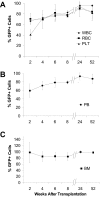Donor cell-derived osteopoiesis originates from a self-renewing stem cell with a limited regenerative contribution after transplantation
- PMID: 18182575
- PMCID: PMC2288731
- DOI: 10.1182/blood-2007-10-115725
Donor cell-derived osteopoiesis originates from a self-renewing stem cell with a limited regenerative contribution after transplantation
Abstract
In principle, bone marrow transplantation should offer effective treatment for disorders originating from defects in mesenchymal stem cells. Results with the bone disease osteogenesis imperfecta support this hypothesis, although the rate of clinical improvement seen early after transplantation does not persist long term, raising questions as to the regenerative capacity of the donor-derived mesenchymal progenitors. We therefore studied the kinetics and histologic/anatomic pattern of osteopoietic engraftment after transplantation of GFP-expressing nonadherent marrow cells in mice. Serial tracking of donor-derived GFP(+) cells over 52 weeks showed abundant clusters of donor-derived osteoblasts/osteocytes in the epiphysis and metaphysis but not the diaphysis, a distribution that paralleled the sites of initial hematopoietic engraftment. Osteopoietic chimerism decreased from approximately 30% to 10% by 24 weeks after transplantation, declining to negligible levels thereafter. Secondary transplantation studies provided evidence for a self-renewing osteopoietic stem cell in the marrow graft. We conclude that a transplantable, primitive, self-renewing osteopoietic cell within the nonadherent marrow cell population engrafts in an endosteal niche, like hematopoietic stem cells, and regenerates a significant fraction of all bone cells. The lack of durable donor-derived osteopoiesis may reflect an intrinsic genetic program or exogenous environmental signaling that suppresses the differentiation capacity of the donor stem cells.
Figures






Comment in
-
Osteopoietic stem cells: transplantable, but regeneratively limited.Blood. 2008 Apr 15;111(8):3917-8. doi: 10.1182/blood-2008-02-135400. Blood. 2008. PMID: 18434966
Similar articles
-
Delayed marrow infusion in mice enhances hematopoietic and osteopoietic engraftment by facilitating transient expansion of the osteoblastic niche.Biol Blood Marrow Transplant. 2013 Nov;19(11):1566-73. doi: 10.1016/j.bbmt.2013.07.025. Epub 2013 Aug 2. Biol Blood Marrow Transplant. 2013. PMID: 23916672
-
Transplantable marrow osteoprogenitors engraft in discrete saturable sites in the marrow microenvironment.Exp Hematol. 2008 Mar;36(3):360-8. doi: 10.1016/j.exphem.2007.11.002. Epub 2008 Jan 7. Exp Hematol. 2008. PMID: 18179857 Free PMC article.
-
Cytokine-induced osteopoietic differentiation of transplanted marrow cells.Blood. 2011 Aug 25;118(8):2358-61. doi: 10.1182/blood-2011-01-331397. Epub 2011 Jun 29. Blood. 2011. PMID: 21715305 Free PMC article.
-
Differentiation of osteoblasts and osteocytes from mesenchymal stem cells.Curr Stem Cell Res Ther. 2008 May;3(2):131-45. doi: 10.2174/157488808784223032. Curr Stem Cell Res Ther. 2008. PMID: 18473879 Review.
-
Intra-bone marrow-bone marrow transplantation: a new strategy for treatment of stem cell disorders.Ann N Y Acad Sci. 2005 Jun;1051:626-34. doi: 10.1196/annals.1361.107. Ann N Y Acad Sci. 2005. PMID: 16127003 Review.
Cited by
-
Mesenchymal Stem Cells in Bone Regeneration.Adv Wound Care (New Rochelle). 2013 Jul;2(6):306-316. doi: 10.1089/wound.2012.0420. Adv Wound Care (New Rochelle). 2013. PMID: 24527352 Free PMC article. Review.
-
Cell sources for bone tissue engineering: insights from basic science.Tissue Eng Part B Rev. 2011 Dec;17(6):449-57. doi: 10.1089/ten.TEB.2011.0243. Epub 2011 Sep 27. Tissue Eng Part B Rev. 2011. PMID: 21902612 Free PMC article. Review.
-
Non-hematopoietic stem cells in umbilical cord blood.Int J Stem Cells. 2009 May;2(2):83-9. doi: 10.15283/ijsc.2009.2.2.83. Int J Stem Cells. 2009. PMID: 24855525 Free PMC article.
-
Amelioration of a mouse model of osteogenesis imperfecta with hematopoietic stem cell transplantation: microcomputed tomography studies.Exp Hematol. 2010 Jul;38(7):593-602. doi: 10.1016/j.exphem.2010.04.008. Epub 2010 Apr 24. Exp Hematol. 2010. PMID: 20417683 Free PMC article.
-
Hematopoietic stem cells give rise to osteo-chondrogenic cells.Blood Cells Mol Dis. 2013 Jan;50(1):41-9. doi: 10.1016/j.bcmd.2012.08.003. Epub 2012 Sep 3. Blood Cells Mol Dis. 2013. PMID: 22954476 Free PMC article.
References
-
- Horwitz EM, Prockop DJ, Fitzpatrick LA, et al. Transplantability and therapeutic effects of bone marrow-derived mesenchymal cells in children with osteogenesis imperfecta. Nat Med. 1999;5:309–313. - PubMed
-
- Brazelton TR, Nystrom M, Blau HM. Significant differences among skeletal muscles in the incorporation of bone marrow-derived cells. Dev Biol. 2003;262:64–74. - PubMed
Publication types
MeSH terms
Grants and funding
LinkOut - more resources
Full Text Sources
Medical

